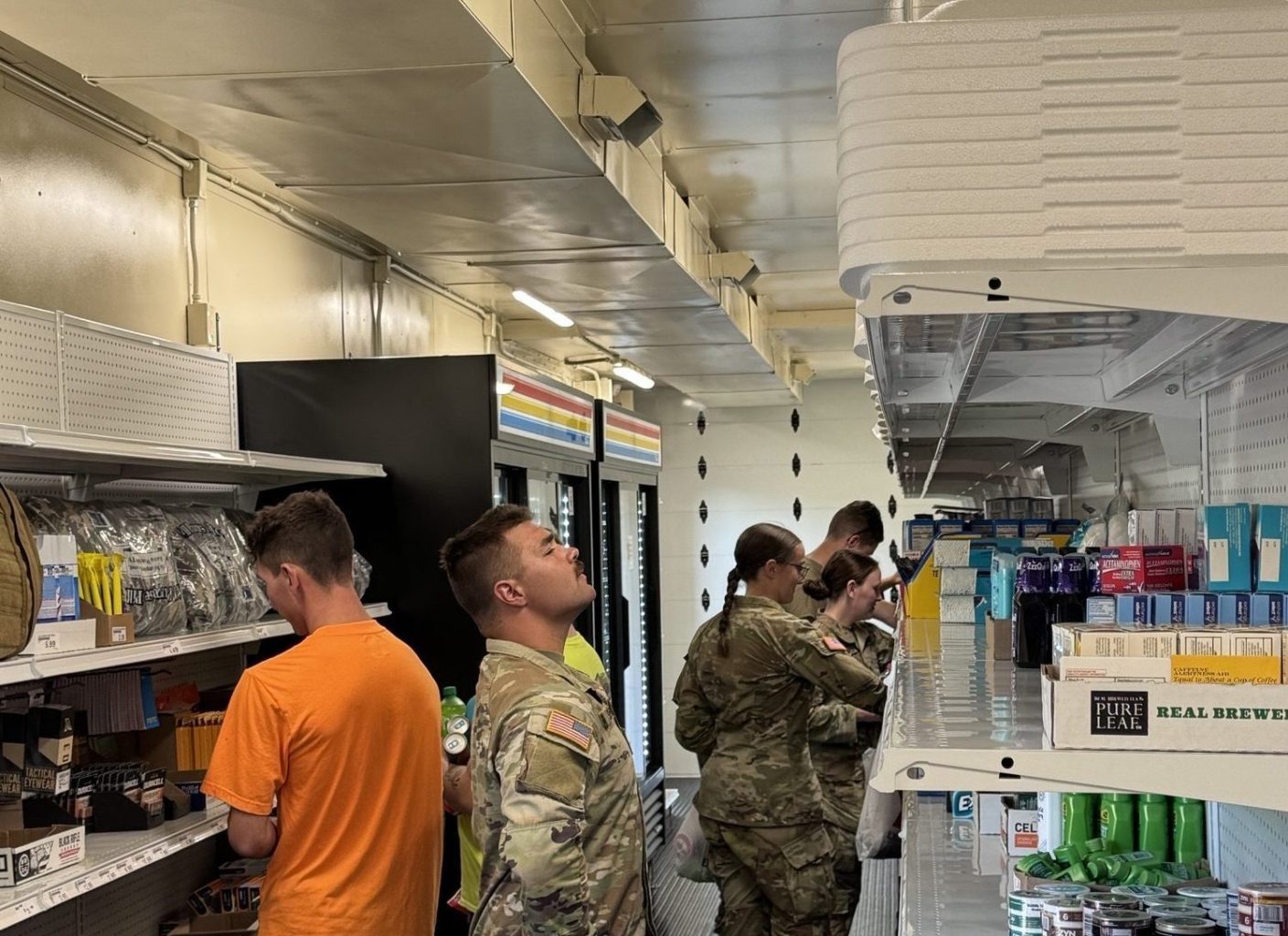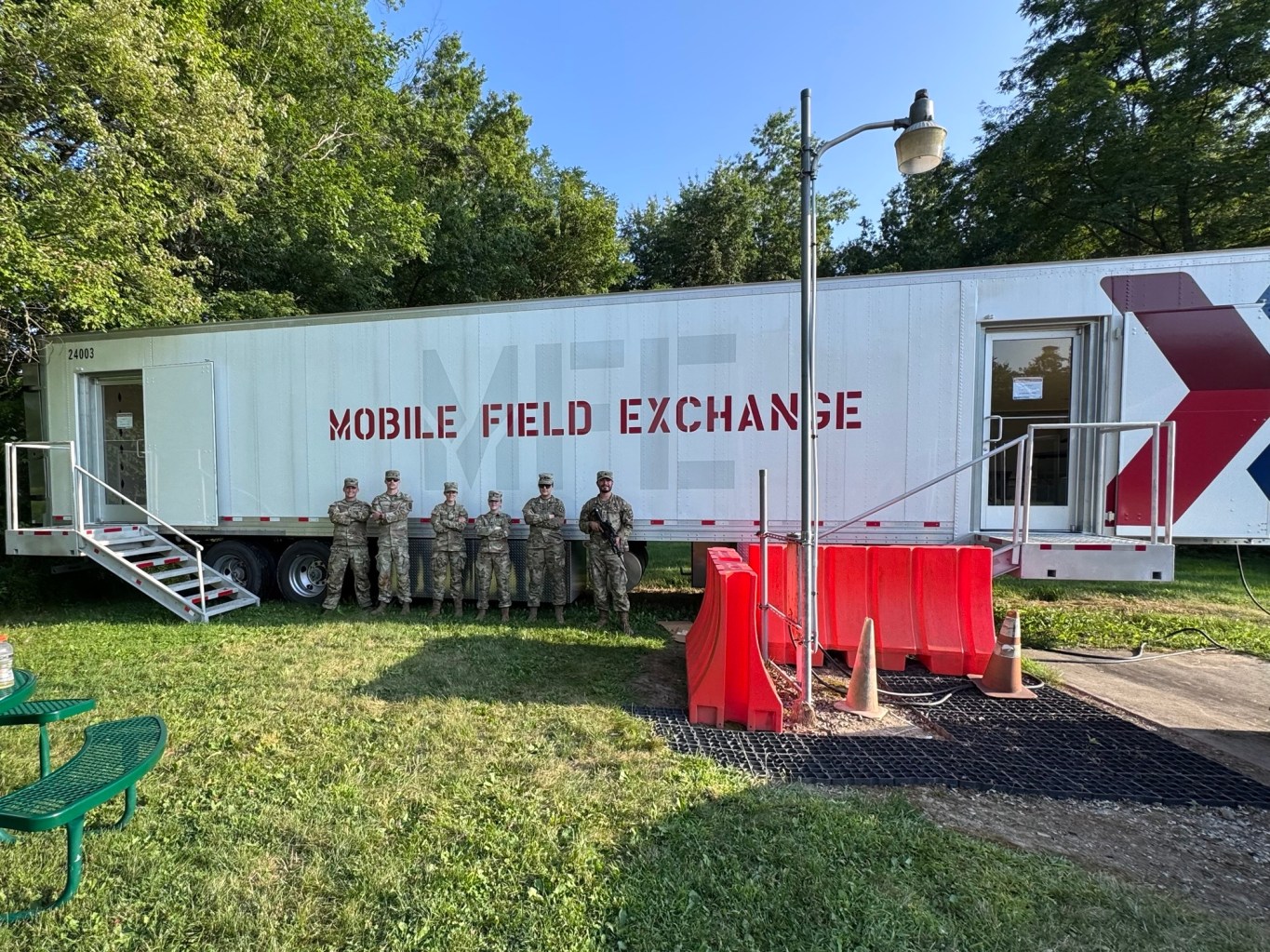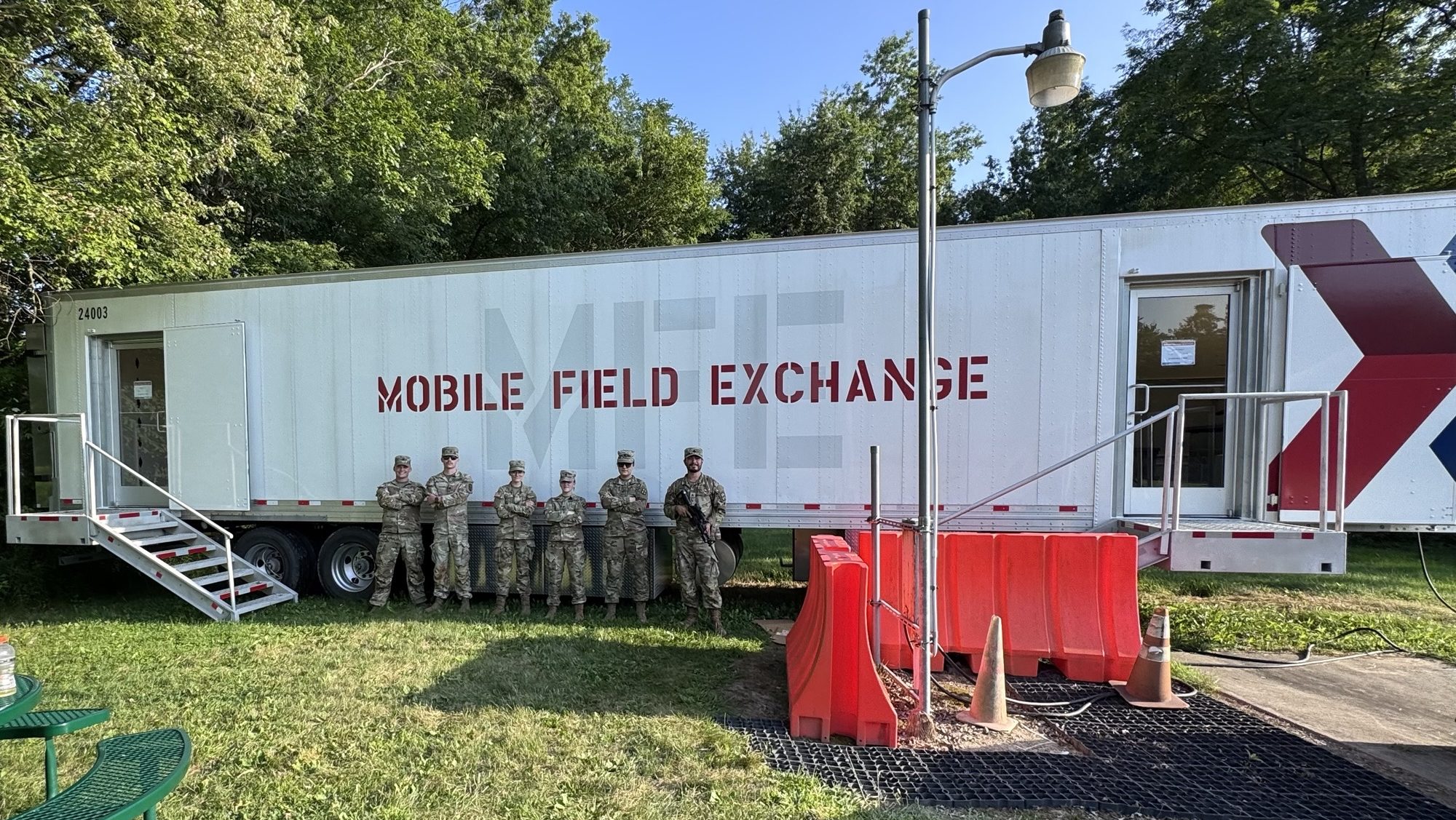Near the end of July, a Mobile Field Exchange (MFE) arrived at Camp Garfield, an Ohio Army National Guard installation that holds training exercises every summer. The Exchange traditionally supports these exercises with an MFE—but this one was different.
“We are modernizing the MFE in terms of all the components that make it an MFE,” said Colice Powell, Exchange Contingency Program Manager, who is a retired Army Colonel. “There’s the trailer itself—it matters that it’s new and doesn’t have wear and tear, but it’s just a trailer. The upgrades also give us the opportunity for new generator sets, new air conditioning units, new refrigerator units.”
In place of bin shelving, the MFE has been fitted with flat shelves that are typical in most stores. Instead of horizontal “bunker” coolers for cold drinks and chilled food, there are vertical stand-up coolers, also resembling what shoppers would see in an Express. Upgrades have also been made to flooring, communication equipment and more.
The new MFE at Camp Garfield—a midsummer replacement for one that had seen better days—is among the first of a series of new CONUS MFEs that will be rolled out during the next few years.
The road to new MFEs
The journey toward the new MFEs began about four years ago, when the Exchange was supporting Operation Allies Welcome, a mission focused on helping Afghans and their families into the United States after the end of the Afghanistan war.
“The Afghan guests were not always close to a store, so we began providing MFEs to support troop concentrations,” Powell said. “What came out of that was questions about the MFE fleet and what kind of shape it was in. The MFEs at the time were actually quite old.”
MFEs usually consist of a trailer, outfitted to sell snacks, beverages, toiletries and other merchandise. “Some of the trailers were part of the regular Exchange fleet before they were converted to MFEs,” Powell said. “So some of them are 20 years old. The major components on them—the axles, the bearings, all the running gear—are aging. Generators may be old. The refrigeration, air conditioning and heating systems are getting old.”
The current CONUS fleet consists of 10 MFEs and two barber trailers (which are also being upgraded). The plan is to expand the CONUS fleet to 11. One of the MFEs is considered a show trailer for outreach events such as the Army-Navy Game; the others are used to support exercises like the ones at Camp Garfield or are on standby for request after natural disasters, such as an MFE that was sent to support the Fort Gordon community last year after Hurricane Helene.
The modernization process began in 2021. Since then, the Contingency Plans team has continued modernization by programming procurement annually through the Exchange CAPEX (capital expenditures) process.

Teamwork makes the MFEs work
In July, Powell, Vice President of Contingency Plans Col. (Ret) Roger Neumann and Chief of Operational Plans Lt. Col Timothy Stephens visited the Waco Distribution Center to tour one of the new MFEs and meet with teammates who worked on the project.
All CONUS MFEs are based in Waco, because having them in one location helps ensure quality control. “It’s a known skill set there,” Powell said. “The systems and processes have been built up around them being there. The Logistics FMO (Facilities Management Office) teams take care of them mechanically, the IT team takes care of all the communication and point-of-sale equipment. The Transportation Fleet team members in Waco are experts in getting them where they need to go.”
MFEs often run on portable generators, which power communications, air conditioning, refrigeration and more.
“We keep some super-ready, like for hurricanes,” Powell said. “But there’s ready and then there’s ready. If you want to be able to back a tractor up to pull an MFE out, it needs to be on electricity so that all the comms systems are up to date. If it’s not, you’ll burn six to eight hours powering it up. You’ll lose about a day in the process.”
Richard Collins, an End User Computer Technician (EUCT) at the Waco DC, said that at the end of a workweek, he’ll make sure the MFEs are plugged into power so that they’re ready to roll if he’s not there.
“Monday morning, I come in and get them all running on generators again,” he said. “If it’s super-hot out here, I have to run the generator to have air conditioning, because the heat will melt our equipment.”
Collins, an Army Veteran, knows the importance of MFEs.
“I used MFEs extensively when I was in the field,” he said. “You’re stuck in the middle of a desert and all of a sudden an MFE rolls in and you’re like, ‘Oh—I can get a Coke!’ It was a sight for sore eyes.”
With the changes to flat shelves and upright coolers, there was no loss in square footage for product shelving and storage.
“The shelves are locked in,” said Heather Shaal, chief of facilities and maintenance for Logistics. “You can’t move them. We bought these and installed them. Going forward, we will buy them and then have a vendor do the installation.”
At checkout, the point-of-sale system is fundamentally unchanged, although there will be new credit/debit card readers to align with the readers in stores. Shaal said she saw opportunities to display Exchange branding in the checkout area.
To help with setup, Collins and another EUCT, Sherrie Galloway, designed a “store in a box,” a large case that holds two registers, two terminals, scanners, PIN pads and more.

Keeping MFEs in touch
Communication capabilities have also been upgraded. “On the communication side, if Wi-Fi is available, we will have a device that allows users to connect to the Exchange network,” Powell said.
For deployments to locations where Wi-Fi is unavailable or down, the new MFEs are equipped with Starlink, which is more user-friendly and versatile than the satellite dishes that have traditionally been used. “With the physical satellite sets, you had to aim them at satellites,” Powell said. “Now we have a number of Starlink systems. If an MFE is sent somewhere without Wi-Fi, or cell towers are down, we can just use Starlink.”
The Starlink receiver looks like a large white square and can be placed anywhere. “All you have to do is grab the antenna, stick it outside somewhere and plug it in,” Collins said. “All the equipment is in a cabinet and it’s already wired. Any place there’s an open piece of sky, you can just throw the antenna on the ground and you’ll have comms.”
Other associates who worked on the project include Shane Wilmoth, facility manager; Phillip Kownatzki, assistant region facility manager; and Todd Hallett, field tech supervisor for the South Central Region. Charlie Jestis, a field support manager who worked on the project, retired at the end of July.
The Camp Garfield MFE is also being used to determine whether any issues need to be addressed with the new units. The MFE was greeted warmly at Camp Garfield, which is overseen by the Youngstown Troop Store, part of the Wright-Patterson AFB Exchange.
“It’s beautiful,” said Jackleen Buzzelli, branch manager. “The troops were so thankful and some have never seen a mobile Exchange, which makes it all worthwhile.”





Leave a Reply